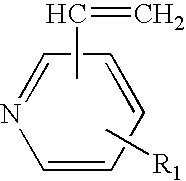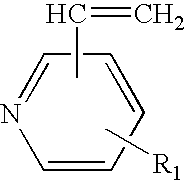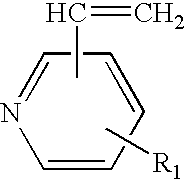Process for production of clay nanocomposite
a technology of nanocomposite and clay, which is applied in the direction of transportation and packaging, special tyres, tyre parts, etc., can solve the problems of clay delamination, layered structure of clay completely disrupted, and not reaching the ultimate dispersion state commonly referred to as exfoliation
- Summary
- Abstract
- Description
- Claims
- Application Information
AI Technical Summary
Problems solved by technology
Method used
Image
Examples
example i
Preparation of Anionic Latex of Vinyl Pyridiene / Styrene / Butadiene Elastomer (VPSBR) by Hot Polymerization
[0101]An anionic aqueous latex of an emulsion polymerization prepared vinylpyridine-styrene-butadiene terpolymer elastomer (VPSBR) having a basic pH in a range of about 10.5 to 11.5 was synthesized by copolymerizing styrene, 1,3 butadiene, and 2- or 4-vinylpyridine monomers in an aqueous medium. The amount of each monomer and the isomer of vinylpyridine used is shown in Table 1.
[0102]For the preparation of the VPSBR latex Sample 2, a hot (65° C.) emulsion polymerization process was conducted in batch.
[0103]The monomer charge, together with an aqueous soap (surfactant) solution, polymerization modifier and initiator were charged to the reactor.
[0104]The soap solution was a mixture of mixed C14-C18 and C16-C18 unsaturated fatty acids, potassium salts (in an amount of about 2.66 phm), a potassium salt of disproportionated rosin acid (in an amount of about 1.4 phm), potassium chlorid...
example ii
Preparation of Anionic Latex of Vinyl Pyridiene / Styrene / Butadiene Elastomer (VPSBR) by Cold Polymerization
[0106]An anionic aqueous latex of an emulsion polymerization prepared vinylpyridine-styrene-butadiene terpolymer elastomer (VPSBR) having a basic pH in a range of about 10.5 to 11 was synthesized by copolymerizing styrene, 1,3 butadiene, and 2- or 4-vinylpyridine monomers in an aqueous medium. The amount of each monomer and the isomer of vinylpyridine used is shown in Table 2.
[0107]The monomer charge, together with an aqueous activator solution, aqueous soap (surfactant) solution, polymerization modifier and initiator were charged to the batch reactor.
[0108]The activator solution was a mixture of ferrous sulfate heptahydrate (in an amount of about 0.009 phm) where phm is parts by weight per 100 parts by weight of monomer sodium formaldehyde sulfoxylate dihydrate (in an amount of about 0.07 phm), tetrasodium ethylenediaminetetraacetate (in an amount of about 0.035 phm) and water ...
example iii
Preparation of Polymer / Clay Nanocomposites
[0110]The following procedure was used to prepare nanocomposites for each of the VPSBR Samples 2-7 of Examples I and II, and for control sample 1. As mentioned previously, control Sample 1 was a commercially available vinylpyridine-styrene-butadiene latex containing 15 percent by weight of 2-vinylpyridine made by a hot polymerization to 100 percent conversion.
[0111]A dispersion of a conventional antioxidant equal to 1 phr (parts by weight per 100 parts by weight rubber) was added to the latex to about 500 grams of the VPSBR latex (19 weight percent VPSBR solids). An aqueous suspension of montomorillonite clay from Southern Clay Products (2.7 w / w percent clay) was used as received. The clay slurry (280 grams) was added to the latex all at once and thoroughly mixed at ambient temperature (about 23° C.). Three kilograms (about 6.6 pounds) of water adjusted to a pH of 2-2.5 with sulfuric acid and heated to 160° F. The clay / latex was added to the...
PUM
| Property | Measurement | Unit |
|---|---|---|
| weight percent | aaaaa | aaaaa |
| temperature | aaaaa | aaaaa |
| temperature | aaaaa | aaaaa |
Abstract
Description
Claims
Application Information
 Login to View More
Login to View More - R&D
- Intellectual Property
- Life Sciences
- Materials
- Tech Scout
- Unparalleled Data Quality
- Higher Quality Content
- 60% Fewer Hallucinations
Browse by: Latest US Patents, China's latest patents, Technical Efficacy Thesaurus, Application Domain, Technology Topic, Popular Technical Reports.
© 2025 PatSnap. All rights reserved.Legal|Privacy policy|Modern Slavery Act Transparency Statement|Sitemap|About US| Contact US: help@patsnap.com



